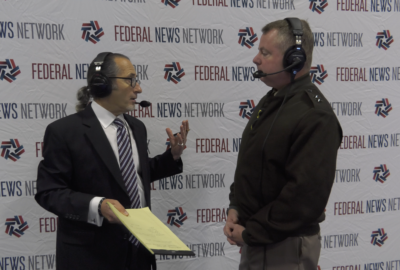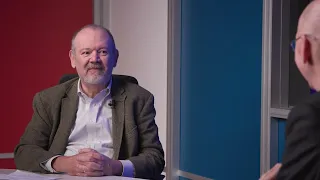Will that bridge collapse in Maryland affect federal supply chains?
Once people got over the shock of the Maryland bridge collapse, the long-term questions started to arise. What about the nation's supply chain?
Once people got over the shock of the Maryland bridge collapse, the long-term questions started to arise. Like, what about the nation’s supply chain, given that the Key Bridge is the entrance to an important shipping port. For analysis, The Federal Drive with Tom Temin spoke with Dr. Philip Evers, University of Maryland supply chain management professor.
Interview Transcript:
Tom Temin What are the supply chain effects? I mean, everything I’ve heard seems to indicate that some automobile shipments will take longer in parts. But is there more to this port than that?
Philip Evers Well, the Port of Baltimore is a mid-sized port relative to other ports in the country. So the port is very important, in the region. But if you look on a national scale, it’s much smaller than a port like, Los Angeles, Long Beach or the Port of New York, New Jersey. So I see a lot of short term issues that arise. Long term, I don’t see major effects outside of the Central Maryland area.
Tom Temin Interesting. So any indications that we have yet. Shipping will return more than we’ll talk about the surface transportation, which is a much longer term effect, but it’ll take them probably months to get the pieces of metal and so forth out so ships can come and go. Fair to say?
Philip Evers Absolutely. But in that time, the freight that would be coming to Baltimore, could, for the most part, be easily diverted to another port.
Tom Temin Yes, because Florida has a couple of big shipping ports, too, right?
Philip Evers Well, there there are ports all up and down the the East Coast, recognized that practically every ship that goes to Baltimore passes in Norfolk. The Port of Virginia is right there. So again, there’s lots for most items, especially for containerized freight, such as the freight that was on the ship that had the incident. Those containers could be offloaded somewhere else. Some of the more specialized freight might be a little bit harder to handle in the short term.
Tom Temin So then again, outside of automobiles, then we don’t really know what is important to the rest of the world coming through Baltimore, because containers on a ship can have everything from computers to whiffle balls.
Philip Evers Sure, absolutely. And we’re kind of thinking about this in terms of imports, but there’s also the export activities. And that I think is going to have maybe a slightly larger effect. Port of Baltimore certainly, handles a lot of export automobiles, but they handle some other export products as well that might affect other places in the world.
Tom Temin For federal government supply chains. Yes, the government buys vehicles, but they buy all of these other commodities, a lot of military gear. It doesn’t seem like this would have that much effect on what the federal government is acquiring.
Philip Evers I can’t imagine that it would have that big of impact, obviously some secondary impacts, but I don’t think anything major.
Tom Temin Now the port will get cleaned up and operational, presumably long before the road over it gets put back together. And that is, as people locally know, part of the Baltimore Beltway, which is a circle, a complete circle. And so when you take out a segment of a circle, you can’t get from point A to point B without going backwards around the long way. What about surface transportation?
Philip Evers I think you hit on the main point. I think the longer term the big issue will be with surface transportation, not with ocean transportation. Because as you say, they will be able to clean once a search and rescue mission are finished. They’ll be able to get onto the removal of the debris in the water, but it’s going to take a long time for that bridge to get rebuilt. And if you think about it, there are four. Well, there were four interstate paths through Baltimore, the two tunnels, the bridge and the other side of the beltway. And now one of those is missing. The Key Bridge certainly handled the fewest automobiles of the four, but it handled a lot of trucking because the trucks that carry hazardous materials are not allowed to go through the tunnels. So that’s one thing that’s going to put more, possibly more trucks around the other side of the beltway jamming that up more.
Tom Temin And you can get off I-95 through Baltimore and go down to a short highway called 395. But within moments you are on narrow surface streets.
Philip Evers Exactly. So for long distance truckers, and of course, anyone driving, let’s say from DC to New York, you’re probably not going to do much of that cutting through the town.
Tom Temin We’re speaking with Dr. Philip Evers. He’s associate professor of supply chain management at the University of Maryland’s business school. There’s a third mode here called rail and the Baltimore Tunnel coming out of the city, going south toward the East coast. That’s long been an object of attention because the bridge, it’s a really old tunnel, and the double piggyback containers that come off of ships sometimes can’t fit two up on a train and get through that tunnel. And wasn’t there infrastructure money at long last to rebuild that tunnel?
Philip Evers Yes. Some of the the very initial work on that is is starting to happen. There’s two tunnels in Baltimore. There’s the Amtrak tunnel, which is an extremely old tunnel, and there is now money and there’s now work progressing on that. And that’s at the very initial stages. There’s also the Howard Street Tunnel, which is a CSX, line. That’s freight only. But that line is now also being expanded, to allow for double stack.
Tom Temin Expanded, meaning they have to scoop it out bigger.
Philip Evers Exactly.
Tom Temin And that’s not a minor engineering thing. I know you’re not an engineer, but that’s not a minor undertaking, is it?
Philip Evers No. In neither of those two tunnels, it cases is that minor. They’re both going to be major project. Much as I’ll point out, and you may recall in in DC, the Virginia Avenue tunnel expansion 10 or 15 years ago was a significant undertaking, but it was done relatively quickly.
Tom Temin And let me ask you about a bigger question. And that is people that are doing procurement on behalf of organizations, in our case, contracting officers. Shipping was something that you consider. Do you think that in the future shipping, shipping methods, shipping costs, shipping warranties should be a bigger part of the thinking of people that are trying to get things acquired and delivered?
Philip Evers Let me come at that in a slightly different perspective. One of the things that occurred during COVID was firms started to really think about the resiliency of their supply chain, especially after 2021. And there were all the problems on the West Coast, in L.A. and Long Beach, firms really started to take resiliency seriously. And so a lot of firms have started to put supply chain backup plans into place. Now we know that plans are always off, but at least firms are now starting to think about these things. So I think in this case, this would be really our first major experience with resiliency planning since firms have really started to kick around this idea. So I’m sure everything won’t go swimmingly, but it will give us experience and I think we will recover better and faster than had firms not been thinking about this to begin with.
Tom Temin And so probably the most critical aspect for the government might be military supplies and deliveries, which are often heavy items or coming by train or full size truck. Therefore, that resiliency would be something military acquisition people should be thinking about.
Philip Evers Sure. Now, again, I don’t know how much military cargo comes directly into a Baltimore.
Tom Temin Probably none.
Philip Evers Probably none. And again, Norfolk is right there. I don’t see this being as big of an impact on the military is more on the commercial side out of Baltimore.
Copyright © 2024 Federal News Network. All rights reserved. This website is not intended for users located within the European Economic Area.
Tom Temin is host of the Federal Drive and has been providing insight on federal technology and management issues for more than 30 years.
Follow @tteminWFED






